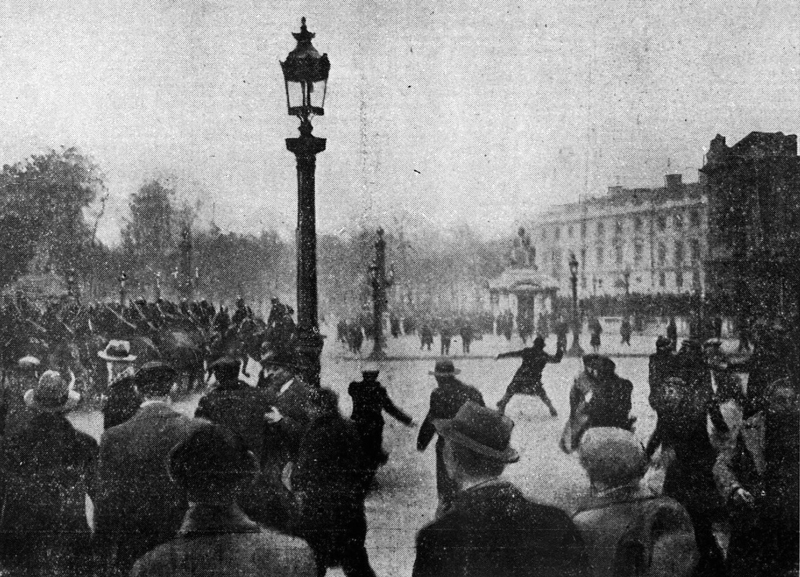 Menu
Menu
 Menu
Menu
Nazis did not introduce illiberalism, authoritarianism, or fascism to France. These ideas had been simmering for years.
Fascism is an extreme right-wing political ideology. It is characterised by things like extreme nationalism, a hate for outsiders and minorities, authoritarian rule, no real democracy, no rule of law, glorification of violence, and a drive towards war. The fascist goal is to overturn the existing order and create a “purified” nation and society.
Fascism emerged in the 1920s. Germany’s Adolf Hitler and Italy’s Benito Mussolini probably are the world’s most recognised fascists. However, fascists could be found almost everywhere following World War I, including Canada.
France’s extreme-right and outrightly fascist political groups of this time included Le Faisceau (The Fascists, 1925), Redressement français (French Resurgence, 1926), and Croix-de-Feu (Cross of Fire, 1927). No group was exactly the same. But in general, they shared ideals like:
Citizens were not immune to these ideas. As one indication, Croix-de-Feu, a paramilitary organisation, had almost half a million members by the mid-1930s. Debate continues on whether they were simply authoritarian or all-out fascist. Historian Robert O. Paxton says “if [they] were fascist, fascism was powerful in 1930s France; if they were not, fascism was limited to the margins.”4
Extreme political conflicts sometimes spilled into the streets. Riots between the political left and the political right were common. The fighting contributed to growing frustration with France’s democracy. It also further drove political polarisation.

Rioters face off against Paris police, February 6th, 1934. Rioters were disorganised and lacked central coordination.
France’s fascist and extreme-right movements appeared to reach a peak on February 6th, 1934. That evening, several of these groups protested in the streets, converging upon Place de la Concorde. This is the square across from France’s parliament. Many wanted to storm the building and replace the government with a dictatorship. Fortunately, they lacked central planning. Police were given orders to fight back: 15 protesters and one police officer were killed.
One consequence of the riot was that it sparked France’s left-wing political groups to put aside their differences and unite against their extremist rivals. An umbrella group called Front populaire (Popular Front) formed, and went on to win France’s 1936 election.
Front populaire’s electoral victory did not spell the end for fascism in France. But it did keep the fascists away from the levers of political power. This new government set to work building social programs, enhancing worker rights, and further preparing France’s defences for a possible German invasion.
Unfortunately, fascism never completely lost its appeal. Many historians believe that the fascist parties were poised to do well in France’s 1940 election. However, that election never came. Germany invaded, France was defeated, and then—backed by public opinion—France’s legislators created a far-right, authoritarian, and perhaps fascist state: Vichy France.
In the late 1930s, the Parti communiste français (PCF) was France’s largest left-wing political party, in terms of membership. Most communists were committed anti-fascists. But the party was also tightly linked with Communist Russia. When Hitler signed a non-aggression pact with Russia in 1939, France banned the PCF.
Following the creation of Vichy, PCF members—already pushed into hiding—were told by party leaders not to openly fight the new regime. After all, Communist Russia was a Nazi ally, and the Nazis were a Vichy ally. This changed when Hitler invaded Russia in June 1941. PCF members swarmed to the Resistance, likely becoming its single-largest contingent.
Later, when Charles de Gaulle set up the Free French government in Algiers, he gave PCF members a seat at the table. Some conservatives were enraged. However, this kept with de Gaulle’s desire to bring together people from diverse political beliefs in the name of liberating France. It also kept with the liberal democratic tradition of incorporating a broad spectrum of views into decision-making.
4 Robert O. Paxton. The Anatomy of Fascism. Vintage Books, 2005, p. 70.
5 Robert Soucy. French Fascism: The Second Wave, 1933-1939. Yale University Press, 1995, p. 112.